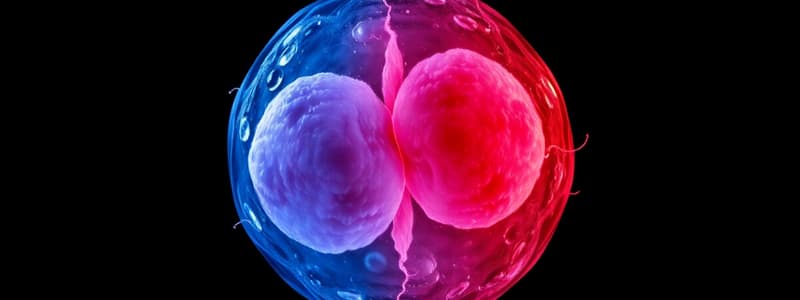Podcast
Questions and Answers
What type of cells are produced by meiosis?
What type of cells are produced by meiosis?
- Somatic cells
- Gametes (correct)
- Diploid cells
- Somatic and gametes
What occurs during prophase I of meiosis that does not occur in mitosis?
What occurs during prophase I of meiosis that does not occur in mitosis?
- Sister chromatids are pulled apart
- Homologous chromosomes pair up (correct)
- Nuclear envelope reforms
- Chromosomes condense
How many times do the phases of PMAT occur in meiosis?
How many times do the phases of PMAT occur in meiosis?
- Once
- Three times
- Four times
- Twice (correct)
What is the result of cytokinesis after telophase I in meiosis?
What is the result of cytokinesis after telophase I in meiosis?
Which statement is true regarding chromatid count after interphase before mitosis or meiosis begins?
Which statement is true regarding chromatid count after interphase before mitosis or meiosis begins?
During anaphase I of meiosis, what is being separated?
During anaphase I of meiosis, what is being separated?
What is the main purpose of crossing over during prophase I of meiosis?
What is the main purpose of crossing over during prophase I of meiosis?
What type of cells does mitosis produce?
What type of cells does mitosis produce?
What occurs during Prophase II in meiosis?
What occurs during Prophase II in meiosis?
How many haploid cells are produced at the end of meiosis?
How many haploid cells are produced at the end of meiosis?
Which statement is true regarding the outcomes of mitosis and meiosis?
Which statement is true regarding the outcomes of mitosis and meiosis?
Which phase of meiosis is analogous to Anaphase in mitosis?
Which phase of meiosis is analogous to Anaphase in mitosis?
What is the primary role of cytokinesis in meiosis II?
What is the primary role of cytokinesis in meiosis II?
Flashcards
Mitosis
Mitosis
The process that creates new body cells, also known as somatic cells.
Meiosis
Meiosis
The process that creates gametes (sex cells like sperm and egg cells).
Diploid (2N)
Diploid (2N)
Having two sets of chromosomes, one from each parent.
Interphase
Interphase
Signup and view all the flashcards
Sister Chromatids
Sister Chromatids
Signup and view all the flashcards
Crossing Over
Crossing Over
Signup and view all the flashcards
Metaphase (Mitosis)
Metaphase (Mitosis)
Signup and view all the flashcards
Cytokinesis
Cytokinesis
Signup and view all the flashcards
Prophase II (Meiosis)
Prophase II (Meiosis)
Signup and view all the flashcards
Metaphase II (Meiosis)
Metaphase II (Meiosis)
Signup and view all the flashcards
Anaphase II (Meiosis)
Anaphase II (Meiosis)
Signup and view all the flashcards
Telophase II (Meiosis)
Telophase II (Meiosis)
Signup and view all the flashcards
Outcome of Meiosis
Outcome of Meiosis
Signup and view all the flashcards
Study Notes
Mitosis and Meiosis - An Overview
- Mitosis and meiosis are cell division processes.
- Mitosis creates somatic cells (body cells).
- Meiosis creates gametes (sex cells—sperm and egg).
- The initial cell is diploid (2N) with 23 chromosomes from each parent in humans.
- Interphase precedes both mitosis and meiosis.
- Chromosomes replicate during interphase, leading to 92 chromatids.
- Interphase is not part of mitosis or meiosis, but it's essential for chromosome duplication.
Comparing Phases of Mitosis and Meiosis I
- Both mitosis and meiosis follow PMAT stages (prophase, metaphase, anaphase, telophase).
- Meiosis progresses through these stages twice (e.g., prophase I, prophase II).
Prophase (Mitosis)
- Chromosomes become visible and condense.
Prophase I (Meiosis)
- Chromosomes condense and pair with homologous chromosomes.
- Homologous chromosomes are identical in size and gene location.
- One chromosome comes from each parent.
- Crossing over occurs, exchanging genetic material, creating recombinant chromosomes.
Metaphase (Mitosis)
- Chromosomes align at the metaphase plate (middle of the cell).
Metaphase I (Meiosis)
- Homologous pairs individually align at the metaphase plate.
Anaphase (Mitosis)
- Sister chromatids separate to opposite poles.
Anaphase I (Meiosis)
- Homologous chromosomes separate to opposite poles.
Telophase (Mitosis)
- Chromosomes reach opposite poles, nuclear envelopes reform.
- Cytokinesis occurs, creating two identical diploid cells.
Telophase I (Meiosis)
- Chromosomes reach opposite poles, nuclear envelopes reform.
- Cytokinesis forms two haploid cells.
Comparing Phases of Mitosis and Meiosis II
- Meiosis II is similar to mitosis.
Prophase II (Meiosis)
- Chromosomes condense in each cell from meiosis I.
- No pairing or crossing over in prophase II.
Metaphase II (Meiosis)
- Chromosomes align at the metaphase plate.
Anaphase II (Meiosis)
- Sister chromatids separate to opposite poles.
Telophase II (Meiosis)
- Chromosomes reach opposite poles, nuclear envelopes reform.
- Cytokinesis forms four haploid cells (gametes).
Outcomes of Mitosis and Meiosis
- Mitosis produces two identical diploid cells.
- Meiosis produces four genetically diverse haploid cells (gametes).
- Human gametes have 23 chromosomes.
- Fertilization (sperm and egg) begins the development of a diploid zygote that undergoes mitosis to form a new individual.
Studying That Suits You
Use AI to generate personalized quizzes and flashcards to suit your learning preferences.





